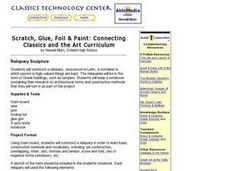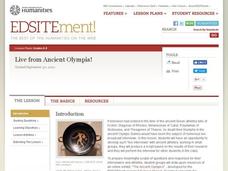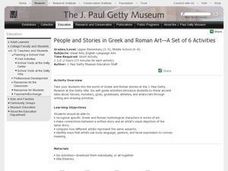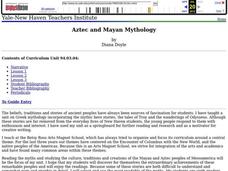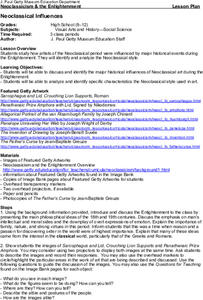Curated OER
The Rise of Christianity in the Roman Empire
Ninth graders investigate the growth of Christianity in Rome. In this Roman Empire activity, 9th graders listen to a SMART Board lecture about the Jesus, Christianity, and the empire prior to composing thematic essays about the spread of...
Curated OER
Mythological Word Origins
Review myths and the characters therein, connecting them to vocabulary words in the English language today. Begin by searching online for myths and character names. With at least ten names that are familiar English words, young scholars...
Curated OER
Greek and Roman Myths in Art-A Set of 7 Activities
Young scholars paricipate in seven activities to investigate ancient stories about heroes, monsters, gods, and goddesses.
Curated OER
Scratch, Glue, Foil & Paint: Connecting Classics and the Art Curriculum
High schoolers construct a reliquary using foam board, researching basic Greek and Roman architecture and basic construction methods. They record their research and information in an architectural journal.
Curated OER
Enduring Influence: Rome, Greece, and Byzantium
Students explore ancient cultures. For this ancient history lesson, students view programs that depict the ancient Roman, Greek, and Byzantine cultures. Students consider how archaeologists, geologists, and scientists have uncovered the...
Curated OER
Live from Ancient Olympia!
Young scholars study online resources to examine the ancient Olympic Games and athletes. They investigate the qualities of ancient Olympic athletes and role interviews with the athletes.
Curated OER
Greek and Roman Art
Sixth graders research ancient Greek pottery online and by watching a video. Then they make a vase design on newsprint and transfer it to cardboard, using crayons and India ink to create a design from their own life.
Curated OER
Ancient Story Problems
Pupils research ancient civilizations, and develop story problems using symbols and coins from those times. They retell these story problems using modern terms and coins.
Curated OER
The Art of Imitation: Writing an Aristotelian Tragedy
Learners, after exploring the history of tragedies and analyzing Aristotelian elements in Greek/Roman tragedies, create their own tragedy set in modern context. They formulate their creations from an Aristotle platform. In addition, they...
Curated OER
An Ancient Greek and Roman Festival
Third graders label a map of ancient Greek and Roman civilizations and do a written report on one element of these two cultures. They participate in discussions of food, farming, daily life and government (among others). Students use the...
Curated OER
J. Paul Getty Museum
Students read mythological Greek and Roman stories. In this mythological lesson plan students read mythological stories about Greek and Roman times. As they read, they compare the written story to the visual art of the story.
Curated OER
Classical Art
Students study the evolution of Greek and Roman art in pottery and human form. They examine how the artistic evolution is related to discoveries in science and travel through the lessons in this unit.
Curated OER
Ancient Greece Predicting Outcomes
Sixth graders explore world history by utilizing a SMART board. In this Greek history instructional activity, 6th graders read different Ancient Greece scenarios and match them with a selection from a list of probable outcomes. Students...
Curated OER
Sophocles' Antigone: Ancient Greek Theatre, Live from Antiquity
Students analyze Antigone and its universal issues as well as explore ancient Greece. In this Antigone and Ancient Greece lesson plan, students read and complete activities for Sophocles' Antigone. Students reconstruct the experience of...
Curated OER
Season Sarcophagus
Students analyze a sarcophagus art and create a similar piece of art. In this sarcophagus art lesson, students investigate possible meanings of the Season Sarcophagus and create a work of art that is similar to the subject or meaning of...
Curated OER
Newspaper (Ancient Rome)
Sixth graders use word-processing software to create a newspaper, as if they were Roman citizens, using information gathered during research.
Curated OER
Art and Influence of Theatre
Pupils examine an 18th century drawing and produce a skit based on the drawing. In this art analysis instructional activity, students analyze the story depicted in a drawing and create a skit inspired the scene. Pupils research the 18th...
Curated OER
Mythology and Ancient Civilizations
Third graders examine ancient world civilizations and the mythologies they created to explain natural phenomena, as well as the writers and poets who wrote about the mythologies.
Curated OER
Aztec and Mayan Mythology
Here's a fresh take on a mythology unit. Use the myths of the Mayan and Aztec peoples of Mesoamerica instead of the more traditional Greek and Roman stories. This abstract suggests possible approaches and resources that can be...
Curated OER
Neoclassical Influences
Students identify artists of the Neoclassical period and how they were influenced by major historical events during the Enlightenment as well as identify the Neoclassical style.In this Neoclassical art lesson,...
Curated OER
Giants of the Past
Learners listen to the book, The Mysterious Giant of Barletta, and create paper sculptures based on ancient Greek and Roman statues in the Getty Museum. They write narrative stories told from the viewpoints of their sculptures.
Curated OER
GODS OF THUNDER: Myths and Mythical Characters
Students explore the myths and legends of the Ancient Greek and Romans in the ten lessons of this unit. Students compare and contrast the myths and the cultures that created them. Norse myths are included in this unit.
Curated OER
Digging Into the Past
Students participate in an excavation simulation, and explore the ruins of Sardis. They ponder which clues scientists use to determine if artifacts found in the excavation are of Persian, Greek, Roman, Byzantine, or Lydian origin.
Curated OER
Referencing the Classical Past
Students discuss the sculptural group of Three Goddessesby Joseph Nollekens in a study of the classical past. In this Classical history lesson, students describe the three figures in the painting and read an excerpt for the story the art...



